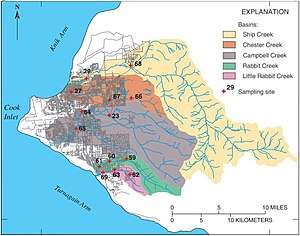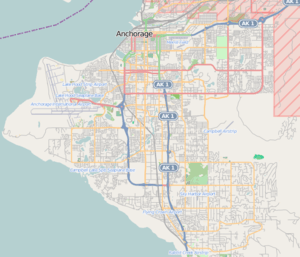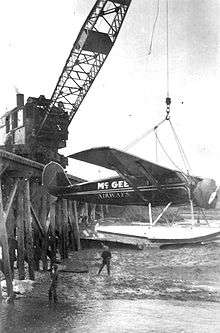Ship Creek, Alaska
Ship Creek is an Alaskan river that flows from the Chugach Mountains into Cook Inlet. The Port of Anchorage at the mouth of Ship Creek gave its name ("Knik Anchorage") to the city of Anchorage that grew up nearby.[1]
| Ship Creek | |
|---|---|
Sunset view of Cook Inlet and Ship Creek, Mount Susitna in background. | |
 Watersheds of Anchorage rivers, with Ship Creek in yellow | |
 Location of Mouth of Ship Creek  Ship Creek, Alaska (Alaska) | |
| Native name | Dgheyaytnu |
| Location | |
| Country | United States |
| State | Alaska |
| Municipality | Anchorage |
| Physical characteristics | |
| Source | Ship Lake |
| • location | Chugach Mountains |
| • coordinates | 61.143°N 149.541°W |
| • elevation | 2,700 ft (820 m) |
| Mouth | Knik Arm, Anchorage |
• coordinates | 61.224°N 149.893°W |
| Length | 25 mi (40 km) |
| Basin size | 114 square miles (183 square km) |
| Discharge | |
| • location | Knik Arm |
| • average | 262 cu ft/s (7.4 m3/s) |
| • minimum | 56 cu ft/s (1.6 m3/s) |
| • maximum | 870 cu ft/s (25 m3/s) |
| Basin features | |
| Tributaries | |
| • right | North Fork Ship Creek |
The river lies entirely within the limits of the Municipality of Anchorage, Alaska. Most of its upper length traverses Joint Base Elmendorf-Richardson.[2]
History
The Dena'ina language name for the creek is Dgheyaytnu.[3] In early 1915, a tent city formed at the mouth of Ship Creek for workers involved in the construction of the Alaska Railroad.[4] This disorganized community was soon relocated south to the bluffs along the creek, forming what would become the early town of Anchorage. In July 1923, President Warren G. Harding arrived at the Ship Creek rail station during his tour of the state to celebrate the completion of the Alaska Railroad and deliver several speeches in Anchorage.[4]

Recreation
Ship Creek is a popular area for sport fishing and is considered the only urban king salmon fishery in the world.[5] It has an annual run of Coho and Chinook salmon and regularly hosts a salmon derby.[6]
Watershed and Hydrology
Ship Creek's headwaters begin high in the Chugach Mountains at Ship Lake. After a swift descent over mountain bedrock, the creek flows along a sloping glacial outwash plain composed of relatively permeable coarse-grained alluvial deposits as it approaches Knik Arm.[7] It has a drainage area of over 100 square miles (160 square km), much of which lies within the Joint Base Elmendorf Richardson military reservation in the Chugach Mountains.[8][9]
The streamflow of Ship Creek has been measured by the USGS since 1946. The mean flow between 1946 and 2020 was 262 cubic feet per second (7.4 m3/s), with the lowest daily flow recorded in 1971 at 56 cubic feet per second (1.6 m3/s) and the highest in 1960 at 870 cubic feet per second (25 m3/s).[8]
Water temperatures range from 0 °C (32 °F) throughout the winter (Dec-Mar) to as high as 15 °C (59 °F) in July.[8]
See also
- Chester Creek (Alaska)
- Campbell Creek (Alaska)
- List of Alaska rivers
References
- Stephen R. Capps. "Bulletin 607: The Willow Creek District Alaska" (pdf). Department of the Interior, US Geological Survey. Retrieved 2020-05-24.
- "Ship Creek". Geographic Names Information System. United States Geological Survey. Retrieved 15 January 2016.
- James Kari and James Fall. "Original Alaska Names by the Original People" (url). Alaska Department of Fish and Game. Retrieved 1 July 2020.
- "Anchorage Centennial: How well do you know Alaska's largest city?" (url). Alaska Dispatch News. August 9, 2015. Retrieved 24 May 2020.
- "AK: World's only urban king fishery has lines casting in downtown Anchorage". Alaska Public Media. June 16, 2017. Retrieved 24 May 2020.
- "Whether you're flying out or in the city, Alaska is what fishing dreams are made of" (url). Anchorage Daily News. April 27, 2019. Retrieved 24 May 2020.
- "Preliminary Report on Water Availability in the Lower Ship Creek Basin, Anchorage, Alaska" (pdf). U.S. Geological Survey. January 1976. Retrieved 24 May 2020.
- "USGS 15276000 SHIP C NR ANCHORAGE AK" (url). National Water Information System. U.S. Geological Survey. 1946–2020. Retrieved 24 May 2020.
- "Ship Creek Data Report 2004-2005" (pdf). Alaska Department of Environmental Conservation. June 2005. Retrieved 24 May 2020.